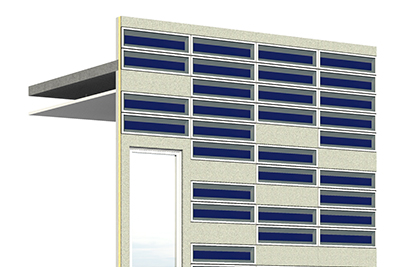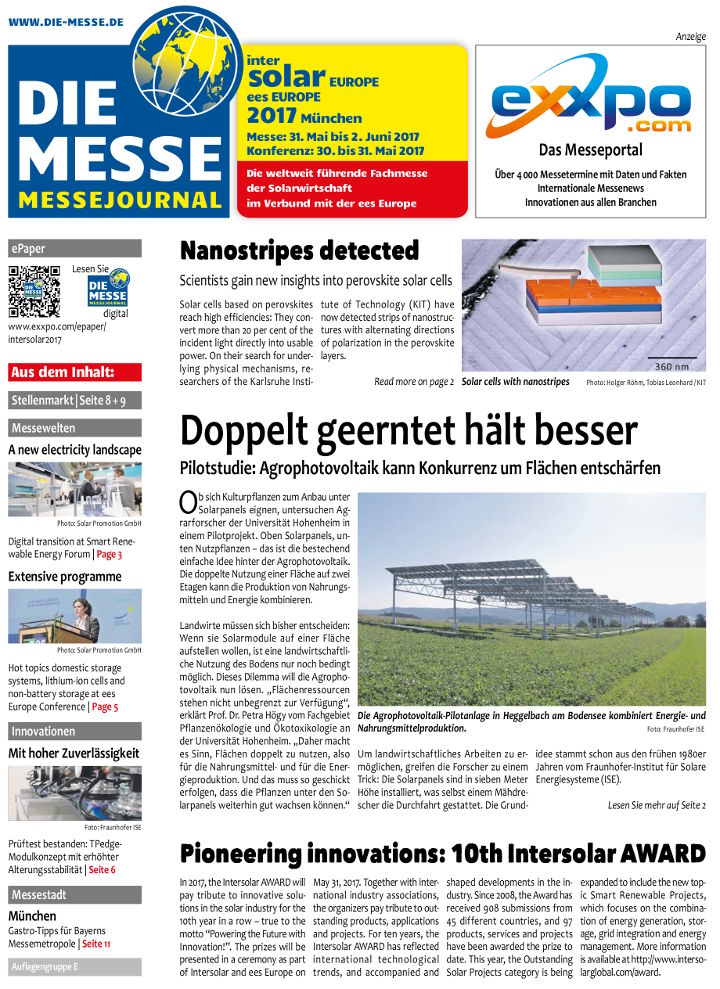23 May 2017
With the “ArKol” project, researchers at Fraunhofer ISE together with partners are currently developing two façade collectors for solar thermal energy generation, which permit a high degree of design flexibility: a strip collector for opaque façade sections and a solar thermal blind for transparent sections.
The first product concept consists of strip-shaped heat pipe collectors which are variable in length and which can be attached flexibly. The heat pipe concept is designed to enable all alignments, including in the horizontal direction. Due to the particular connection to the heat collector, researchers anticipate that a reduced thermal resistance will be possible. The collector connection is provided in the form of a heat pipe which engages in a form-fit manner with a corresponding extruded collection duct.
It also enables an infinitely variable, flexible distance of the individual heat pipes, thus further contributing to the individualization of the application. “The strip collector combines a high level of efficiency with architectural design diversity”, says Dr.-Ing. Christoph Maurer, Head of Team Solar Thermal Facades, at Fraunhofer ISE. “Classic materials such as wood or plaster, structures and colours can be used in the area between the glazed collector strips.”
The second product concept is a solar thermal blind which for the first time enables the energetically optimal regulation of the energy flows through the façade. In order to achieve this effect, blind slats can be used with spectral selective coating. Heat is transported via a heat pipe from the slat to the side collection duct. If external blinds are not required or are not possible, blinds are already now being inserted between two glass panes. “These blinds reach high temperatures, which increase the cooling requirement of the building. The solar thermal blinds can move just as freely as a normal blinds, but at the same time, they deliver heat and reduce the amount of energy entering the interior of the building”, says Maurer.
Designer’s façade: new concepts of solar building envelopes
Among the general public, solar thermal energy is currently associated with dark blue, rectangular collectors on building roofs. Technologies are needed for aesthetically high quality architecture which offer the architect more room for manoeuvre when it comes to low- and plus-energy buildings.
 Photo: Facade-Lab Photo: Facade-LabVisualization of a façade with a solar thermal blind |
The first product concept consists of strip-shaped heat pipe collectors which are variable in length and which can be attached flexibly. The heat pipe concept is designed to enable all alignments, including in the horizontal direction. Due to the particular connection to the heat collector, researchers anticipate that a reduced thermal resistance will be possible. The collector connection is provided in the form of a heat pipe which engages in a form-fit manner with a corresponding extruded collection duct.
It also enables an infinitely variable, flexible distance of the individual heat pipes, thus further contributing to the individualization of the application. “The strip collector combines a high level of efficiency with architectural design diversity”, says Dr.-Ing. Christoph Maurer, Head of Team Solar Thermal Facades, at Fraunhofer ISE. “Classic materials such as wood or plaster, structures and colours can be used in the area between the glazed collector strips.”
The second product concept is a solar thermal blind which for the first time enables the energetically optimal regulation of the energy flows through the façade. In order to achieve this effect, blind slats can be used with spectral selective coating. Heat is transported via a heat pipe from the slat to the side collection duct. If external blinds are not required or are not possible, blinds are already now being inserted between two glass panes. “These blinds reach high temperatures, which increase the cooling requirement of the building. The solar thermal blinds can move just as freely as a normal blinds, but at the same time, they deliver heat and reduce the amount of energy entering the interior of the building”, says Maurer.
More news about "Intersolar Europe":
23 May 2017
Intersolar Europe: A new electricity landscape
The digital transformation in the energy industry has fundamentally changed the electricity landscape. In the future, the energy supply will be ensured by a range of renewable energy plants, storage systems and consumers acting as prosumers. The Smart Renewable Energy Forum at Intersolar Europe is therefore focusing on new concepts and technologies for digital networking along the energy value-added chain. (more…)28 April 2021
The smarter E Europe to be held as The smarter E Europe Restart 2021 in October
Due to the pandemic, The smarter E Europe and its four concurrent energy exhibitions Intersolar Europe, ees Europe, Power2Drive Europe and EM-Power Europe will no longer take place from July 21–23, 2021. Instead, The smarter E Europe Restart 2021 will be staged at Messe München from October 6–8. The smarter E Industry Days, including the award ceremony for The smarter E AWARD, Intersolar AWARD and ees AWARD 2021, will be held online from July 21–23, 2021 when the in-person event should have taken place. (more…)
| FAIR NAVIGATOR ENERGIES | |
|---|---|
|
| E-PAPER INTERSOLAR EUROPE |
 |
